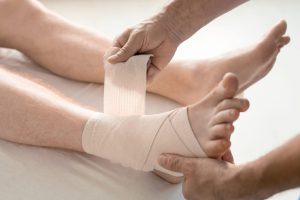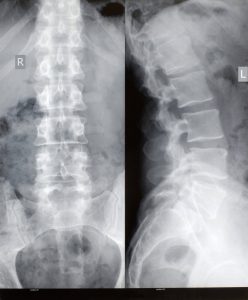The Most Common Car Accident Injuries and What to Do Next
A car accident can damage any area of the body from head to toe. The most prevalent car accident injury is a soft tissue injury, such as a sprain or strain. Mild crash injuries, such as cuts and bruises, are also very common after a collision. However, a car accident injury may also be severe.
The state of Kentucky classifies crash injuries as either a “physical injury” or “serious physical injury.” According to Kentucky Penal Code KRS 500.080, a “physical injury” refers to substantial bodily pain or impairment. Common physical injuries include muscle sprains and broken bones.
A “serious physical injury” is bodily harm that creates a risk of death, disfigurement, or prolonged impairment of health or bodily function. Common serious injuries include traumatic brain injuries (TBI) and spinal cord injuries that can cause paralysis.
After a car accident, you can expect physical pain from both types of bodily injuries. A physical injury may require a few weeks of medical treatment, but serious injuries may require long-term care. Without immediate medical attention, both injuries can cause chronic pain.
If you’ve been hurt in a car accident, see a doctor immediately. Only a medical professional can provide you a proper diagnosis for your car accident injury. Once you begin treatment, learn how a car accident attorney can help you seek compensation for the following types of car accident injuries.
Broken Bones
A broken bone occurs when the force of impact from a collision causes the bone to partially or entirely crack. Also referred to as a fracture, a broken bone from a car accident is common in the arms, wrists, ribs, legs, and ankles. In severe cases, a car accident may cause a broken pelvis.
Symptoms of a broken bone include pain at the injury site a well as loss of function. The severity of a broken bone ranges from a simple fracture to a compound fracture.
Simple Fractures
A simple fracture is a broken bone of any size, including a hairline fracture or a tiny crack in the bone. Symptoms of a simple fracture may appear right away, and they may worsen when you put pressure on the affected area. Treatment for a simple fracture includes resetting the bone and immobilizing it in a splint or cast for four to eight weeks.
Compound Fractures
A compound fracture is a more severe break when the broken bone punctures through the skin. For this reason, a compound fracture is also referred to as an open fracture. This car accident injury demands immediate medical attention and may require surgery or the insertion of metal rods to reset the bone.

Hands of rehabilitation clinician wrapping foot and ankle of patient with flexible bandage during medical procedure on couch in hospital
Soft Tissue Injuries
Soft tissue injuries are the most common car accident injuries. Nearly half of the human body comprises soft tissue, including muscles, ligaments, and tendons. Depending on which type of soft tissue was injured and the extent of the damage, soft tissue injuries can be classified in one of four ways.
Strains
A strain is a type of soft tissue injury that occurs when the individual fibers that make up a muscle or tendon are overstretched. Strains are more likely to happen when tendons or muscles are active during a crash, such as tightly holding a steering wheel. Symptoms of a strain include stiffness, swelling, muscle spasms, pain and tenderness at the injury site, and restricted range of motion.
Sprains
A sprain occurs when the short, flexible fibers that make up a ligament are stretched or overextended. A ligament connects bone to bone or holds together a joint. Strains are common when the bone or joint connected to a ligament is also injured. Symptoms of a strain include pain, inflammation, redness at the injury site, and limited mobility.
Tears
A tear can occur in any type of soft tissue, from muscles and tendons to ligaments. A tear happens when the fibers in the tissue completely rip. Symptoms of a muscle tear may mimic a strain or sprain but will likely be more severe. Where a strain or sprain may heal on its own with rest, a serious tear may require surgery to fix.
Whiplash
Also known as a neck sprain or strain, whiplash is a type of soft tissue injury. Whiplash occurs when the neck and head move rapidly inside the vehicle, rushing forward and backward and tearing soft tissue like muscles and tendons.
Severe whiplash injuries may also injure the surrounding structures in the neck, like facet joints or vertebrae. Symptoms of a whiplash injury include headaches at the base of the skull, dizziness, fatigue, neck pain and weakness, and stiffness. Treatment for whiplash may involve pain medication, a neck brace, and chiropractic care, much like other common neck injuries.
Neck Injuries
Neck injuries refer to any type of damage to the cervical spine, which runs from the base of the skull to the top of the shoulders. Common neck injuries after a car accident include neck sprain and strains, cervical fractures, and herniated discs. Symptoms of neck injury include limited mobility and range of motion, pain and tenderness, dizziness, and fatigue.
Back Injuries
Back injuries include any damage to the spinal column, which runs from the base of the skull to the top of the hips. Common back injuries after a car accident include a herniated disc, bulging disc, facet joint injury, fractured vertebrae, and lumbar sprains and strains. Back injuries from a car accident can cause chronic pain, stiffness, and tingling or radiating pain in the legs. The most severe back injuries are spinal cord injuries.

Spine xray
Spinal Cord Injuries
Spinal cord injuries refer to damage to the column of nerve tissue that extends from the bottom of the brainstem to the lower back. The spinal cord is one-half of the central nervous system (CNS) and controls communication from the body to the other half of the CNS, the brain. Any type of damage to the spinal cord can cause lasting side effects and is considered a serious physical injury.
Damaged vertebrae in the back can put pressure on the spinal cord, causing nerve pain, numbness, or tingling. A severe bone fracture can penetrate or sever the spinal cord, causing total paralysis (quadriplegia or tetraplegia) or paralysis of the lower body and legs (paraplegia). Spinal cord damage is a type of injury that requires immediate medical attention.
Traumatic Brain Injuries (TBI)
A traumatic brain injury (TBI) is a brain dysfunction caused by a violent blow to the skull. When the head collides with a hard object—such as the dashboard, steering wheel, or side window—it can force the delicate brain to slam against the skull wall. This motion can cause swelling, bleeding, or bruising inside of the brain.
Concussions are a common yet mild type of TBI that often involves symptoms like loss of consciousness, temporary memory loss, headaches, dizziness, and confusion. Concussion symptoms may be delayed for seven to 10 days after an accident.
More severe TBIs often involve more serious symptoms, such as nausea and vomiting, trouble concentrating, ongoing memory loss, insomnia, and personality changes. Serious TBIs will require emergency care to ensure blood is not collecting on the surface of the brain.
Other Head Injuries
Aside from concussions and other TBIs, various additional head injuries can occur from a car accident. Traumatic accidents may cause a skull fracture or a break in the bones of the skull. Striking the head against the dashboard or seatbelt may also cause a hematoma or a blood clot inside the brain. Seek medical attention for pain in the skull, confusion, or vomiting.
Hand and Wrist Injuries
Hand and wrist injuries refer to damage of bones, joints, cartilage, and soft tissues. These injuries are common during a vehicle collision, especially when accident victims use their hands as a shield against a deploying airbag. Common hand and wrist injuries include fractures, sprains, strains, and nerve damage. Symptoms include pain and stiffness, limited range of motion, and bruising.
Shoulder Injuries
The shoulder is a type of ball-and-socket joint that connects the shoulder blade to the upper arm. Many strong ligaments keep this joint in place. The restriction of a seatbelt plus blunt trauma from slamming into a side window can cause several shoulder injuries, including a fracture, rotator cuff tear, or ligament sprain. Symptoms of a shoulder injury include swelling, bruising, weakness, and difficulty moving the arm.

Foot and Ankle Injuries
Feet are necessary to operate a vehicle, so they’re often injured during a collision. The force of impact can cause ankle, foot, and toe fractures, as well as sprains and strains. Feet and toes may also be severed during a traumatic crash. Foot and ankle injuries often cause swelling and inflammation as well as a limited range of motion.
Knee Injuries
Knee injuries are very common during an auto accident. Victims often acquire what’s known as “dashboard knee”, or a collection of fractures, sprains, and bruises that result from the knee slamming against the dashboard. Symptoms of a knee injury include swelling, stiffness, burning or tingling under the kneecap, and an inability to put pressure on the leg.
Hip Injuries
The hip is another ball-and-socket joint that can be severely injured during a car crash. Injuries such as tendonitis, bursitis, fractures, hip dislocations and sprains are common in the hip. Symptoms of a hip injury include loss of muscle strength, pain when walking, limping, swelling, and bruising. Hip pain after a car accident may be delayed by several days.
Chest Injuries
Chest injuries from a car accident are often the result of blunt force trauma caused by the body colliding with the steering wheel, dashboard, seat belt, or airbag. Common chest injuries include bruised or broken ribs and muscle damage. Complications from fractured ribs can also cause chest injuries, such as a punctured lung or cardiac contusion, which require urgent medical care.
Internal Injuries
Internal injuries refer to damage to organs like the lungs, heart, kidneys, and stomach. Signs of an internal injury typically include deep bruising, difficulty breathing, nausea, vomiting, and fever. If you’re experiencing stomach pain after a car accident, be sure to visit a doctor to ensure you didn’t suffer an internal injury like peritonitis, abdominal muscle bruising, or a bruised lung.
Crush Injuries
As the name might suggest, crush injuries occur when the force of an accident causes bones to shatter completely. Crush injuries can also injure soft tissues and crucial nerves. These injuries are common in roll-over collisions and typically impact the hands and feet. Crush injuries are usually apparent at the scene of the accident and will require immediate medical attention.
Limb Loss and Amputation
Much like crush injuries, limb loss and amputation occur when the force of a car crash seriously damages a body part enough to either totally sever it or render it unable to heal. These injuries are common in roll-over collisions and high-speed car crashes. Limb loss injuries are often cited as some of the most serious physical injuries.
Cuts, Bruises, and Road Rash
Between broken glass and loose objects such as cell phones or water bottles, anything in a vehicle during an accident can become a projectile that can cause bodily harm. The most common types of injuries from projectiles include:
- Contusions or bruises.
- Lacerations or deep cuts.
- Abrasions or surface scrapes.
- Road rash or abrasions caused by asphalt wearing away the surface of the skin on impact.
Burns
Burns are a type of bodily injury caused by a fire or significantly hot surface. During motor vehicle accidents, burns are often caused by airbag deployment, dangerous chemicals, or explosions within the vehicle. Burns are classified as first-degree, second-degree, and third-degree, of which the latter can permanently damage soft tissue, blood vessels, and nerves.
Disfiguring Facial Injuries and Scarring
In personal injury law, burns or deep lacerations that leave permanent marks on the skin are known as disfiguring facial injuries or scarring. This type of damage is considered a serious physical injury as it will remain with the victim for the rest of their life. While these injuries aren’t fully realized at the time of the accident, severe cuts or burns may indicate a future of disfigurement.
Post-Traumatic Stress Disorder
Post-traumatic stress disorder (PTSD) is an emotional injury that can haunt victims of a traumatic accident. Emotionally, PTSD is characterized by irritability, hypervigilance, anxiety, and depression. Mentally, PTSD may cause flashbacks, insomnia, and nightmares. It may be difficult for victims with PTSD to enter or drive a vehicle.

What to Do After Suffering a Car Accident Injury?
If you have suffered from a car accident injury, the most important thing is to seek medical attention. If you’re physically able, contact the authorities and go with them to the emergency room for an immediate physical examination. Not only will instant medical care help your injuries from worsening, but formal documentation will also act as a record of injury for your insurance claim.
After a car accident injury:
- Seek a formal diagnosis and begin injury treatment, such as physical therapy.
- File an accident report, even for minor crashes. Police reports are an excellent source of evidence for an insurance claim and may identify witnesses at the scene of the accident.
- Contact your insurance company and provide the contact information for the other driver. These details can be found in the police report if you could not get them at the scene.
- Seek a car accident attorney to calculate your damages and file a personal injury claim or lawsuit for compensation for your car accident injury.
In a personal case, damages are the expenses you incur as a result of your injury. Damages usually include past and future medical bills, lost wages, and pain and suffering. The compensation you are entitled to will depend on the severity of your injuries. The more severe injuries will incur more medical expenses resulting in higher compensation.
The average settlement for a car accident with an injury is approximately 1.5 times your financial losses. A potential settlement amount can range from $15,000 to $1,500,000. The amount of compensation you may receive for your injuries is not guaranteed and will vary depending on the unique facts of your case.
Contact an Experienced Car Accident Attorney After Suffering Injuries in a Car Accident
If you were recently injured in a collision that was limited or no fault of your own, you do not deserve to struggle under the weight of medical expenses, lost wages, and unpaid debt. Instead of handling your car accident injury alone, seek the help of a trusted car accident lawyer.
At Bryant Law Centers, our dedicated attorneys will work around the clock to fight for the compensation you deserve. Contact us today for a free, non-committal consultation to learn how to take the first steps of your personal injury claim.
